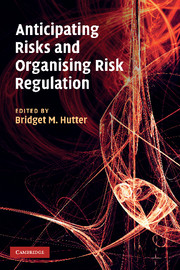Book contents
- Frontmatter
- Contents
- Contributors
- Preface
- Part I Introduction
- Part II Threat, vulnerabilities and insecurities
- 2 Risk society and financial risk
- 3 Before the sky falls down: a ‘constitutional dialogue’ over the depletion of internet addresses
- 4 Changing attitudes to risk? Managing myxomatosis in twentieth-century Britain
- 5 Public perceptions of risk and ‘compensation culture’ in the UK
- 6 Colonised by risk – the emergence of academic risks in British higher education
- Part III Social, organisational and regulatory sources of resilience and security
- References
- Author index
- Subject index
2 - Risk society and financial risk
Published online by Cambridge University Press: 10 November 2010
- Frontmatter
- Contents
- Contributors
- Preface
- Part I Introduction
- Part II Threat, vulnerabilities and insecurities
- 2 Risk society and financial risk
- 3 Before the sky falls down: a ‘constitutional dialogue’ over the depletion of internet addresses
- 4 Changing attitudes to risk? Managing myxomatosis in twentieth-century Britain
- 5 Public perceptions of risk and ‘compensation culture’ in the UK
- 6 Colonised by risk – the emergence of academic risks in British higher education
- Part III Social, organisational and regulatory sources of resilience and security
- References
- Author index
- Subject index
Summary
Introduction
The financial markets crisis which has developed since the middle of 2007 can largely be described in the same terms as previous financial crises, namely as a ‘crash’ following a ‘boom’ (Bank for International Settlements 2008b) or a ‘mania’ (Kindleberger 2000). A combination of loose monetary conditions, financial innovation and speculation – fuelled by ignorance and greed – pushed up the price of assets in an (initially) self-fulfilling manner until the negative shock of losses on sub-prime mortgages in the United States created ‘panic’ and a sharp fall in asset prices. Similarities may also be drawn with Minsky's (1975 and 1986) ‘financial instability hypothesis’, in which a period of prolonged stability and prosperity can generate speculative activity which in turn creates financial instability. But a richer analysis can be derived by also considering financial risk in the context of the characterisation of modern society as a ‘risk society’ (Beck 1992; Giddens 1999b; cf. Bartrip, Boin, Hofmann, Huber, Lloyd-Bostock, this volume). This provides part of the explanation of why poor risk management failed to prevent ‘mania’ and ‘panic’ and reinforced the ‘crash’.
This chapter focuses on financial innovation in the development of financial derivatives and securitisations since the early 1970s, and on the consequences of this in the financial markets crisis since the middle of 2007. It illustrates how financial markets overestimated the extent to which financial risks can be identified and controlled and how they failed to recognise and control new and unanticipated risks generated by financial innovation.
- Type
- Chapter
- Information
- Anticipating Risks and Organising Risk Regulation , pp. 25 - 45Publisher: Cambridge University PressPrint publication year: 2010
- 1
- Cited by



